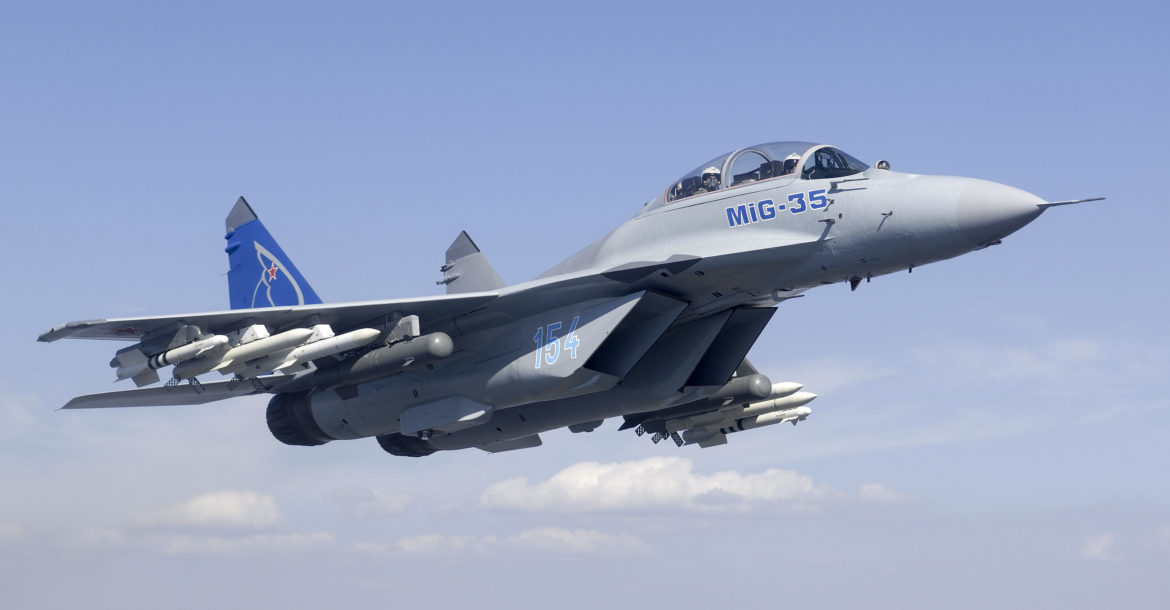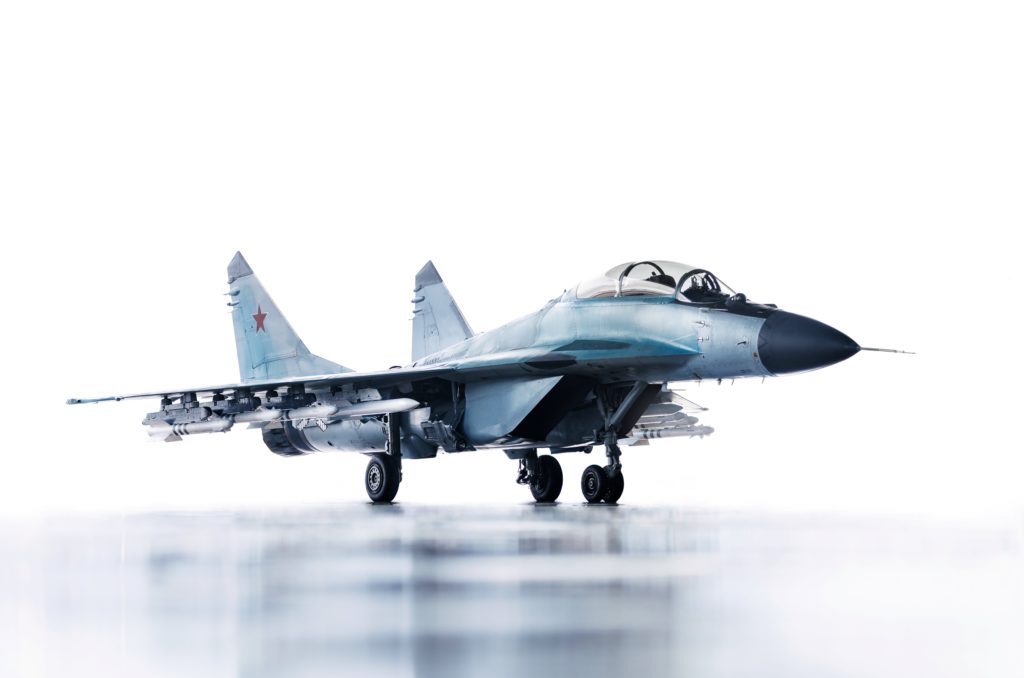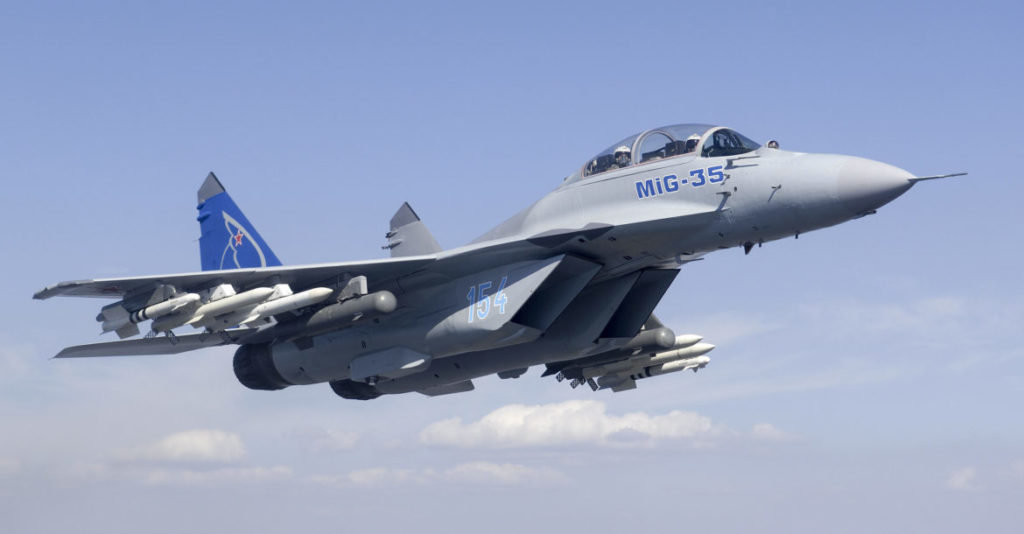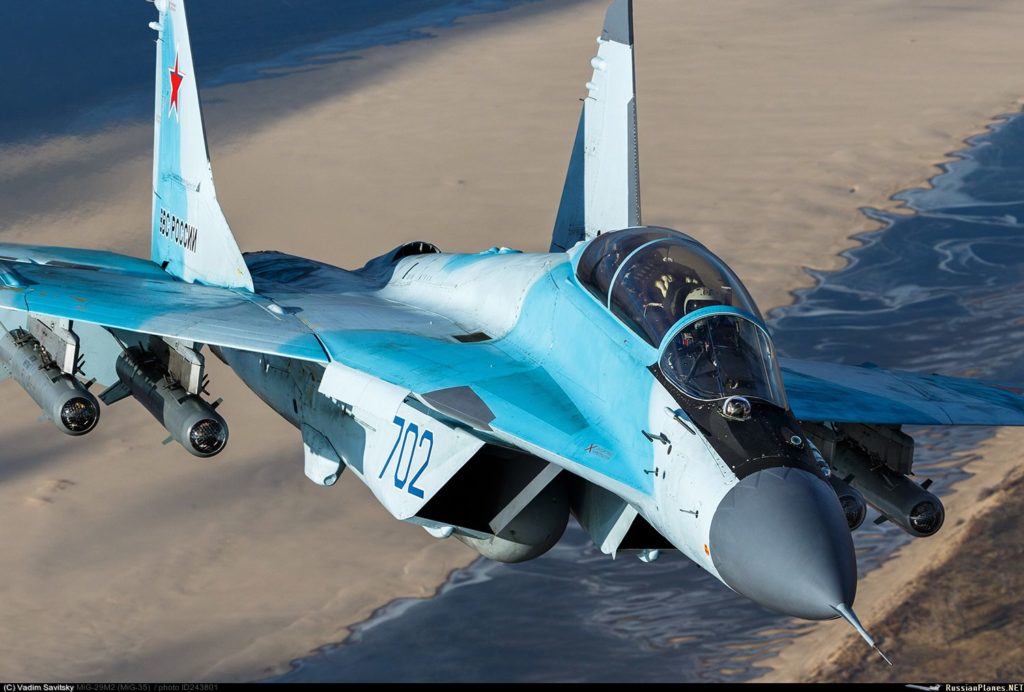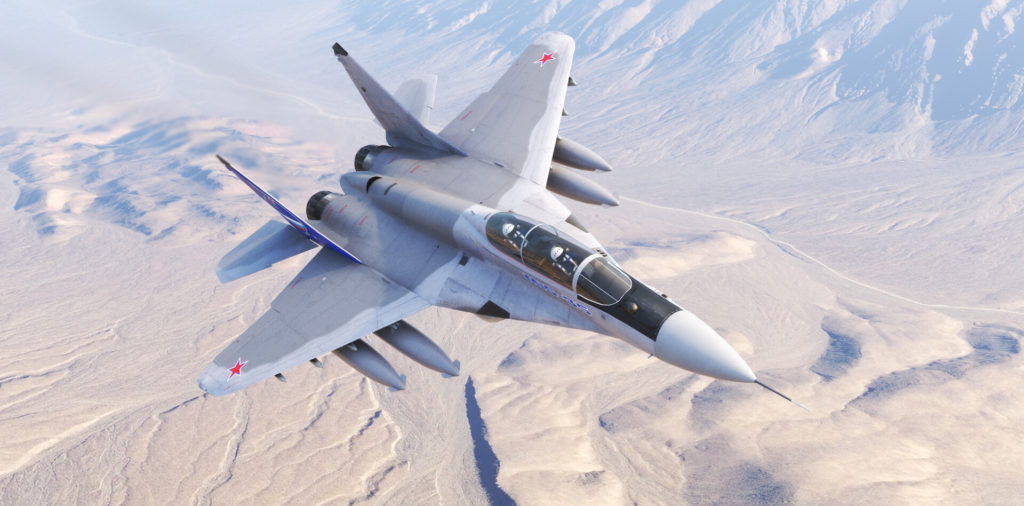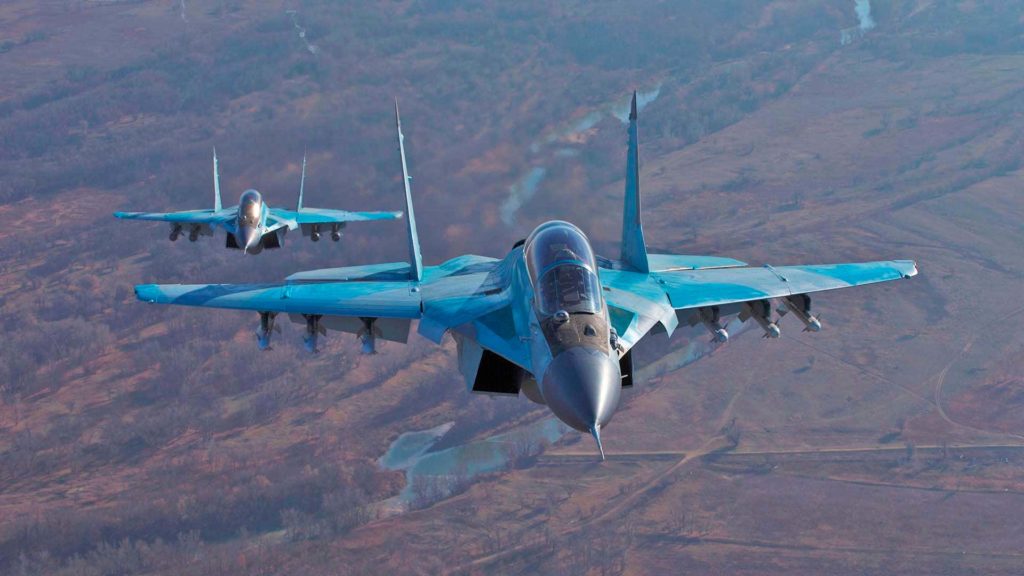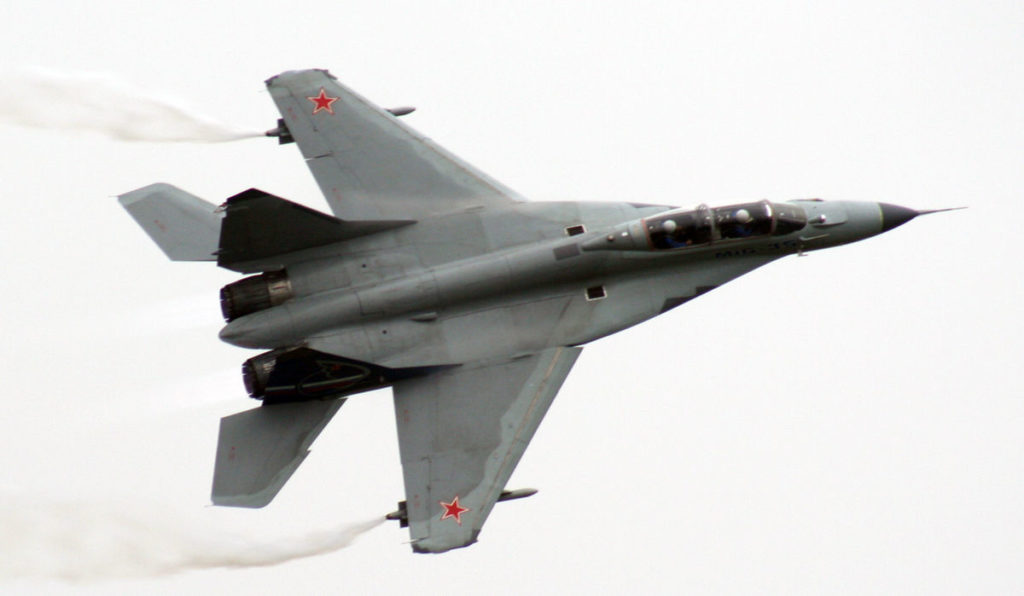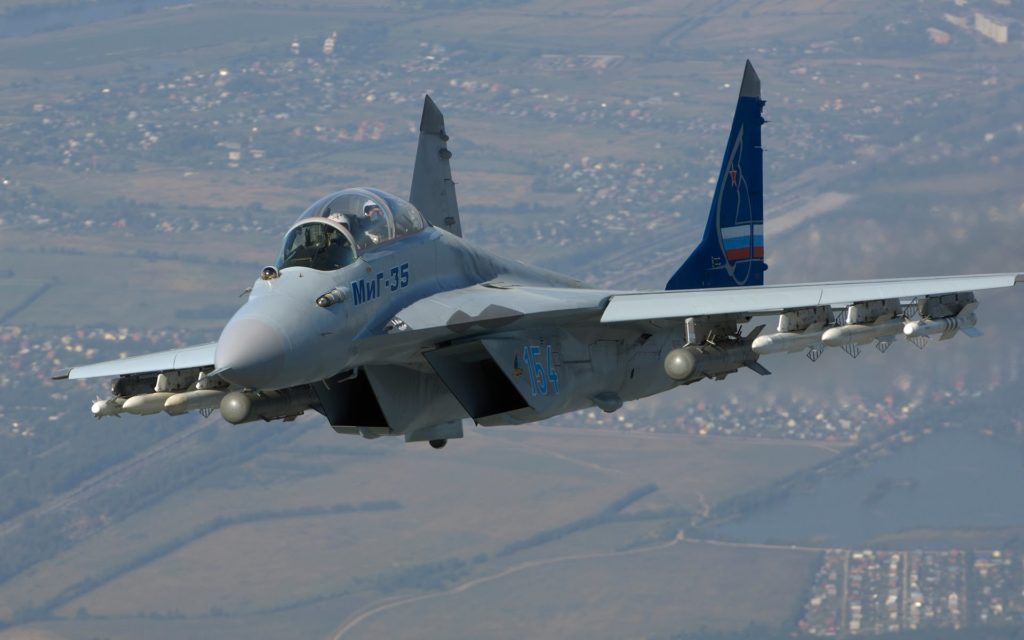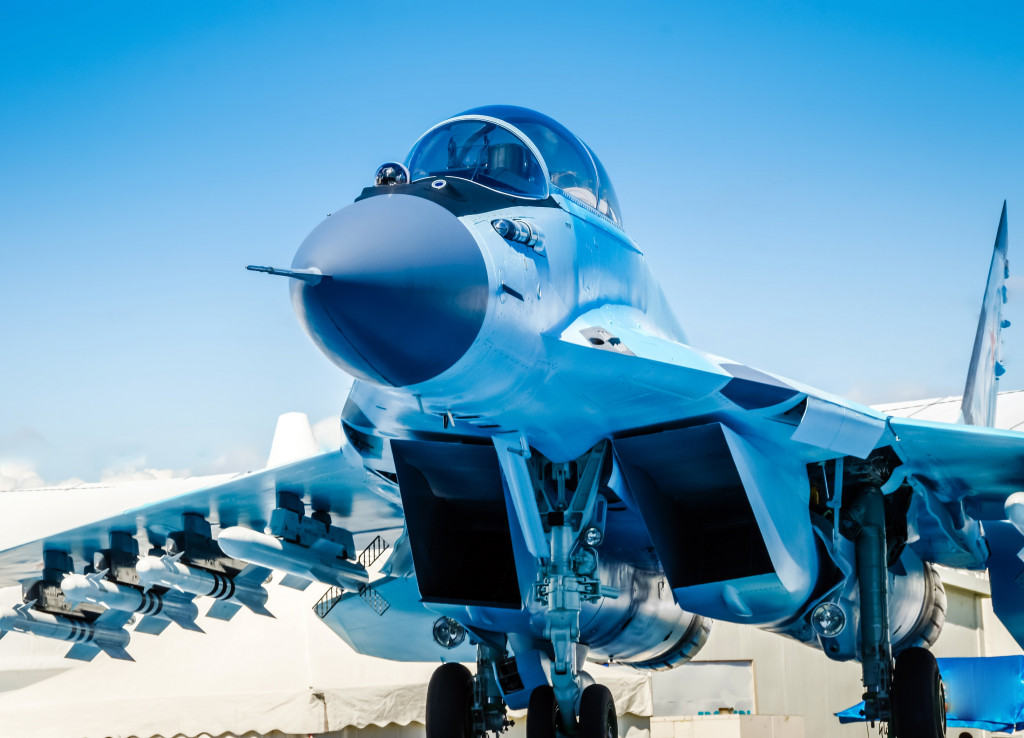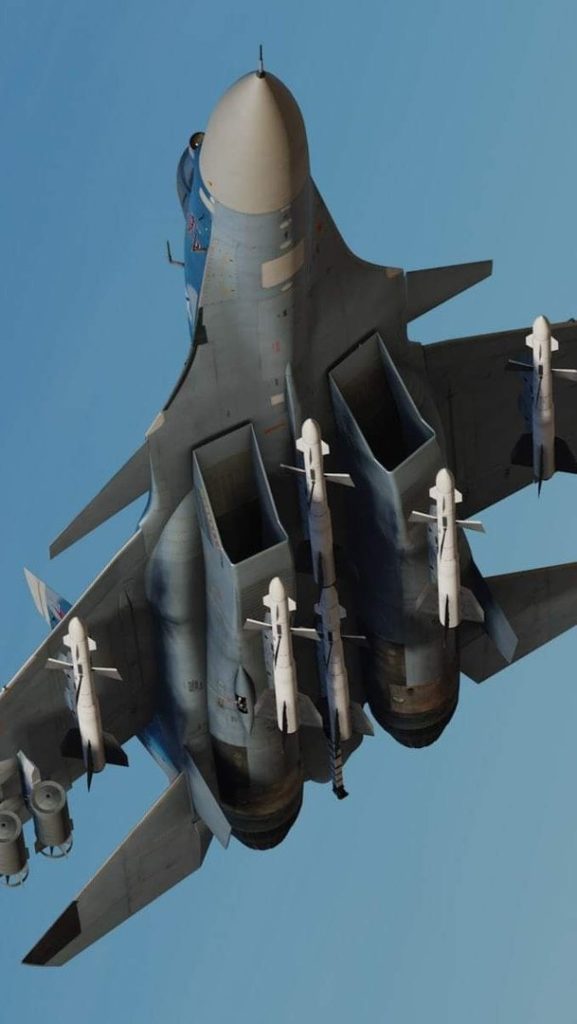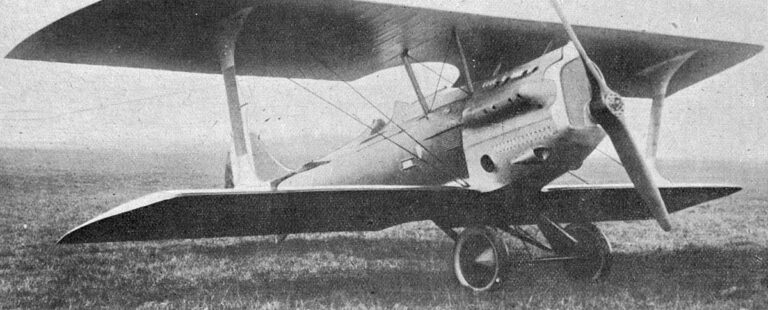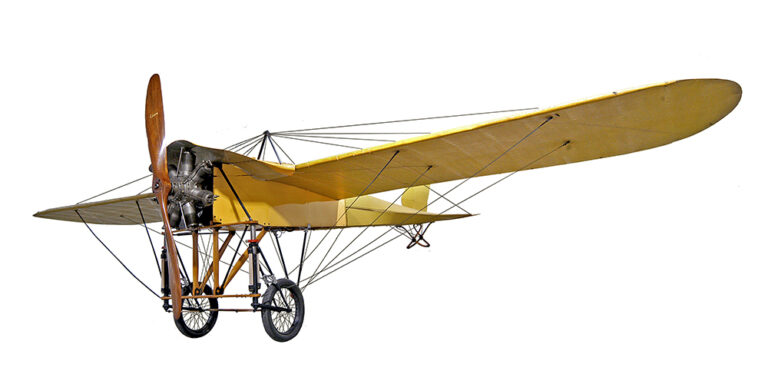Views: 4
Information
The Mikoyan MiG-35 (Russian: Микоян МиГ-35; NATO reporting name: Fulcrum-F) is a Russian multirole fighter that is designed by Mikoyan, a division of the United Aircraft Corporation (UAC). Marketed as a 4++ generation jet fighter, it is a further development of the MiG-29M/M2 and MiG-29K/KUB fighters.[7][8] According to a Russian defense industry source Mikoyan MiG-35 is essentially an upgraded variant of MiG-29KR.[9][6] Many consider MiG-35 is a new name given by Mikoyan for marketing.[10][11][12][13][14] The first prototype was a modification of the aircraft that previously served as a MiG-29M2 model demonstrator. Mikoyan first officially presented the MiG-35 internationally during the 2007 Aero India air show.[15] but the first two serial production aircraft entered service in 2019.[12]
The single-seat version is designated MiG-35S and the two-seat version MiG-35UB.[14] The fighter has vastly improved avionics and weapon systems than early variants of MiG-29, notably new precision-guided targeting capability and the uniquely designed optical locator system, which relieves the aircraft from relying on ground-controlled interception systems and enables it to conduct independent multirole missions. Serial production aircraft use a PESA radar and there is also an option available for AESA radar.[12][6] The serial production aircraft does not have an option for thrust vectoring control as previously planned.[16]
Contents
1 Development
1.1 Origins
1.2 Procurement
1.3 Initial flight testing
2 Design
2.1 Overview
2.2 Engines
2.3 Armament
2.4 Cockpit
2.5 Avionics
3 Operational history
3.1 Russia
3.2 Potential operators
3.2.1 Egypt
3.2.2 India
3.2.3 Argentina
3.2.4 Others
4 Variants
5 Operators
6 Specifications (MiG-35)
7 See also
8 References
8.1 Notes
9 External links
Development
Origins
There were references in the late 1980s to a very different design also identified as “MiG-35”. This design was a single-engined combat aircraft for air-to-air and secondary air-to-ground roles. According to unidentified Indian sources, the aircraft was evaluated by Indian pilots in the Soviet Union and was probably suggested as an alternative for the Indian LCA being developed at that time.[17]
Procurement
A pre-series MiG-35D at the 2007 Aero India air show
Russia unveiled the MiG-35 at the 2007 Aero India air show in Bangalore,[18] amid Moscow’s keenness to sell these planes to India. The MiG-35 was a contender with the Eurofighter Typhoon, Boeing F/A-18E/F Super Hornet, Dassault Rafale, Saab JAS 39 Gripen, and General Dynamics F-16 Fighting Falcon in the Indian MRCA competition for 126 multirole combat aircraft to be procured by the Indian Air Force. Deficiencies with the MiG-35’s radar and its RD-33MK engines led to the fighter being ousted from the contest in April 2011.[19][20][21]
In May 2013, it was reported that Russia intended to order 37 aircraft.[22] In August 2013, the Russian Defense Ministry stated that the purchase worth RUB37 billion ($1.1 billion) would be delayed until 2016 due to the spending cuts in the state arms program for 2014–2016.[23]
In August 2015, Colonel General Viktor Bondarev, commander of Russia’s Air and Space Forces stated that MiG-35 development was to be completed in 2017; entry into service is to follow in 2018.[24] The state tests of the MiG-35 were to begin in 2017 with completion in mid-2018 after the serial production of the aircraft would have started.[25] According to Viktor Bondarev, Russian Aerospace Forces plans to replace its whole fleet of light fighters with the MiG-35s and thus there is a need for at least 170 of such aircraft.[26]
During 2016, first two pre-production aircraft were being built at the Production Center No.1 in Lukhovitsy.[citation needed] Both aircraft were delivered at the end of the year.[citation needed]
In July 2017, during the MAKS 2017 International Aviation and Space Salon, the Russian Defence Ministry agreed it will buy 24 MiG-35s as a part of the new state armament program for 2018–2027. Six out of the 24 MiG-35s will replace the aging MiG-29s of the Russian Swifts aerobatic team.[27][28] On 22 August 2018, during the International Military-Technical Forum «ARMY-2018», the first contract for six MiG-35s was signed.[29] The Russian Aerospace Forces plans to sign a second contract for delivery of 14 MiG-35s in 2020.[30]
On 17 June 2019, Russian Aerospace Forces received the first two serially produced MiG-35s, marking the introduction of the variant into service.[2][31]
Initial flight testing
By April 2010, pictures and additional information surfaced of two new MiG-35 demonstrators, the single-seat MiG-35 “961” and the two-seat MiG-35D “967”. According to Russian media, they first flew in autumn of 2009, and subsequently took part in MMRCA trials in India in October 2009. Both have a very high commonality with the previous MiG-29K/KUB airframes, an immediate visible difference being the braking parachute installed in place of the hook, present on the naval aircraft.[32] Subsequently, the MiG-35D “967” appears to have been equipped with a similar AESA radar as fitted to the older MiG-35 demonstrator “154”, identifiable by the dark grey short nose radome.[33]
On 6 September 2016, according to the general designer of the United Aircraft Corporation Sergei Korotkov, first MiG-35s were to be delivered in November 2016 to the Russian Air Force for flight testing to confirm the technical characteristics of the aircraft.[34][35] First of the two aircraft, single-seat MiG-35 “702” made its first flight on 24 November 2016, followed by double-seater MiG-35UB “712” in December 2016.[4]
On 28 January 2017, MiG officially demonstrated one of the two pre-production aircraft, MiG-35UB “712”, to the Russian government, followed by subsequent demonstration for export customers on the next day.[36][37] The newly presented MiG-35 showed to be a bit different with the one unveiled in 2007, the aircraft allegedly lacked the AESA radar as well as thrust vectoring control, supposedly to keep procurement cost low to attract foreign customer.[38]
In July 2017, the director general of the MiG, Ilya Tarasenko, told the press: “We are now testing, and after the results will begin mass production. Serial production will begin within the next two years.”[39][40]
In February 2017, it was announced contract was signed to built another two pre-production aircraft that will join the testing. It was also expected state trials will begin at Chkalov State Flight Test Centre in Akhtubinsk the same year.[41]
In February 2018, MiG Aircraft Corporation announced that it had completed factory trials of the MiG-35, the certificate of the trials completion having been signed in December 2017.[42][43]
In May 2018, head of the United Aircraft Corporation Yuri Slyusar reported that state trials of the MiG-35 had begun.[44]
In April 2019, MiG-35UB “11” first took off to join the testing. This is first of the two additional pre-production aircraft ordered in February 2017.[5]
Design
[icon]
This section needs expansion. You can help by adding to it. (February 2019)
Overview
The MiG-35/MiG-35D incorporate advancements of the MiG-29K/KUB and MiG-29M/M2 fighters in combat efficiency enhancement, universality and operational characteristics improvement.[45] The main features of the new design are the fifth-generation information-sighting systems, compatibility with Russian and foreign weapons applications and an integrated variety of defensive systems to increase combat survivability. The new overall design overtakes the design concepts of the baseline model and enables the new aircraft to conduct full-scale multirole missions as their western counterparts.[45]
New avionics are intended to help the MiG-35 gain air superiority as well as to perform all-weather precision ground strikes, aerial reconnaissance with opto-electronic and radar equipment and to conduct complex joint missions.[45] This includes the Phazotron Zhuk-AE active electronically scanned array (AESA) radar, the RD-33MK engines and the newly designed optical locator system, OLS-35.[46][47][48] The number of weapon stations has increased to 10, flight range has increased by 50%, and radar visibility has been reduced.[49]
The final configuration of the MiG-35’s onboard equipment has been left open intentionally using the MIL-STD-1553 bus.[50] Weight load 7 tons (twice the weight load of the MiG-29).[51][52]
Engines
A pre-series MiG-35D taking off
The MiG-35 is powered by two FADEC RD-33MK Morskaya Osa (Russian: Морская Оса, literally: “Sea Wasp” or Chironex fleckeri) turbofans. The RD-33MK a highly improved variant and the latest version of the Klimov RD-33 turbofan and was intended to power the MiG-29K and MiG-29KUB. It has 7% more power compared to the baseline model due to the use of modern materials in the cooled blades, providing a higher thrust of 9,000 kgf. In response to earlier criticism, the new engines are smokeless and include systems that reduce infrared and optical visibility.
According to episode 160 of the Russian military documentary film “Combat Approved”, plans for a thrust vectoring variant of MiG-35 were cancelled due to increased weight ratio and the need to reduce costs.[16] A previously planned thrust vectoring MiG-35 variant was planned to include thrust vectoring nozzles that could direct thrust on two different axis.[45][53] As of 2012, the only in-service, in-production fighter jet using this technology is the Sukhoi Su-35. Other current thrust-vectoring aircraft, such as the Sukhoi Su-30 and the Lockheed Martin F-22 Raptor, have nozzles with thrust vectoring in one axis.[54][51][55]
Armament
In January 2017, during a conference call with Russian President Vladimir Putin, Yuri Slyusar, president of the UAC, reported that the MiG-35 could possibly use a kind of laser weaponry in the future.[56] Military trials of the laser are to proceed immediately after flight testing of the aircraft.[57] However, there was doubt if Slyusar made a mistake by saying laser weaponry instead of laser-guided weapon.[58] The MiG-35 is also planned to be capable of launching the Kh-36 Grom-1 cruise missile, giving it a long-range strike capability that the MiG-29 does not possess.[59]
Cockpit
The MiG-35 has a glass cockpit equipped with night-vision goggles, an additional display for the optical locator system, and a 3-equal-size color LCD multi-function display. The second-seat version of the MiG-35, the MiG-35D, has 4 LCD displays in its rear cockpit.[60] The MiG-35D uses a tandem cockpit while single-seat versions of the MiG-35 uses the rear cockpit to store extra fuel, while retaining a two-seat canopy.[61]
Avionics
13SM-1 optical-location station of the MiG-35
Serial production MiG-35s are now equipped with a PESA radar of Zhuk family. Russia also offered Zhuk-A/AM AESA radar for export market.[6][62]
Some sources stated the MiG-35 was to be equipped with the new Phazotron Zhuk-A/AE active electronically scanned array (AESA) radar, the first radar of this kind installed on a Russian fighter aircraft.[63][12] The Phazotron Zhuk-A/AE AESA radar offers a wider range of operating frequencies, providing better resistance to electronic countermeasures (ECMs), extended detection range and more air and ground targets detected. The FGA-35 radar type, featured 688 mm antenna and 1016 T/R modules (originally planned 1064) with initial stage performance of a 200 km detection range for 3m2 RCS target. Later detection range was raised up to 250 km.[64] It can track up to 30 targets at any time, engaging up to 6 air targets at once, or 4 ground targets at once.[65]
For detection of targets in the infrared spectrum, the MiG-35 is equipped with the OLS-UEM (13SM-1) electro-optical targeting station with lookdown capability against ground, sea and air targets. Its forward-looking infrared (FLIR) sensor is capable to detect airborne threats up to 55 km and provides coverage in azimuth of +/- 90-degree and +60-degree to −15-degree in elevation.[66][67] The OLS-UEM consists of:
Infra-red search and track sensor
TV camera with infrared search and track capability
Multimode laser rangefinder with detection range up to 20 km
There is also the OLS-K/OLS-KE podded electro-optical targeting system mounted under the right engine nacelle. It is designed to search, detect and track ground and sea targets. The system consists of infrared sensor and TV camera and is capable to detect ground targets up to 20 km and sea targets up to 40 km.[68]
To protect the aircraft against current and future surface-to-air (SAM) missiles, the MSP-418KE compact active jammer pod can be mounted on any of the aircraft nine hardpoints.[69]
Operational history
Russia
The Russian Defence Ministry intended to place an order for 37 aircraft in 2013,[22] but the number was reduced to 24 in August 2017.[27] First batch of six MiG-35s was ordered in August 2018,[29] and first two serial aircraft were delivered to the Russian Aerospace Forces on 17 June 2019.[2]
Potential operators
Egypt
Main article: Mikoyan MiG-29M § Egypt
In 2014, Egypt planned to sign a large arms deal with Russia for the purchase of 24 MiG-35 fighters.[70][71][72] In February 2015, MiG Director General Sergei Korotkov announced that the company was ready to supply the MiG-35 jets to Egypt should the country request them.[citation needed] However, in April 2015, Egypt signed a $2 billion contract for the purchase of 46 MiG-29M/M2 multi-role fighters instead.[73][74]
India
The MiG-35 was a contender with the Eurofighter Typhoon, Boeing F/A-18E/F Super Hornet, Dassault Rafale, Saab JAS 39 Gripen, and General Dynamics F-16 Fighting Falcon in the Indian MRCA competition for 126 multirole combat aircraft to be procured by the Indian Air Force. During the competition however, India’s Ministry of Defense was frustrated with the problems of the aircraft’s avionics with the radar not able to achieve the maximum targeting distance during tests. Also the RD-33MK engines were not shown to reach sufficient thrust. As a result, the MiG-35 was ousted from the contest in April 2011.[19][75][76]
The aircraft is now competing with 6 other aircraft in a fresh tender which is referred as MMRCA 2.0 in the Indian media, for the procurement of 114 multi-role combat aircraft.[77]
Argentina
In 2021 Russia offered Argentina a deal for the MiG-35 with also includes Kh-35 anti-ship missile and Kh-38 air-to-surface missiles.[78][79][80]
Others
Peru, Bangladesh and Myanmar were among other countries interested in acquiring MiG-35 fighters.[81]
In 2019, there were reports that the Russian government had proposed providing two squadrons of MiG-35s to the Royal Malaysian Air Force, to replace its MiG-29N fleet. The RMAF had previously mothballed its MiG-29s due to high maintenance costs and downtime. As part of the deal, Malaysia would have returned 18 MiG-29Ns to Russia. This was the essence of an offer made by Russian President Vladimir Putin to Malaysia in August 2019.[82]
Variants
MiG-35
Single-seat variant[60]
MiG-35D
Two-seat variant[60]
MiG-35S
Single-seat serial. The varient has an extra fuel tank in the place of second pilot seat.
MiG-35UB
Two-seat serial
Naval version
According to the General Director of Mikoyan, Ilya Tarasenko, a carrier-based version of the MiG-35 is under development.[83] Concern Radio-Electronic Technologies has already adapted a new landing system to the BINS-SP-2 deck for the MiG-35.[84]
Export version
According to the General Director of UAC, Yuri Slyusar, they will create an export version of the MiG-35 fighter with a new cockpit.[85][86] Export customers can chose Zhuk-A/AM AESA radar instead of PESA radar of serial production MiG-35.[6][62]
Operators
Russia
Russian Aerospace Forces
Russian Air Force
Specifications (MiG-35)
MiG-35UB pre-series at the MAKS 2017 International Aviation and Space Salon
Export version of MiG-35 at the MAKS 2019 International Aviation and Space Salon
Data from Rosoboronexport MiG-35/35D,[87][7] Mikoyan MiG-29M2 basic dimensions,[88][89] deagel.com,[90] airforce-technology.com[91]
General characteristics
Crew: 1 or 2
Length: 17.3 m (56 ft 9 in)
Wingspan: 12 m (39 ft 4 in)
Height: 4.73 m (15 ft 6 in)
Wing area: 41 m2 (440 sq ft)
Empty weight: 11,000 kg (24,251 lb)
Gross weight: 17,500 kg (38,581 lb)
Max takeoff weight: 24,500 kg (54,013 lb)
Max landing weight:16,800 kg (37,000 lb)
Powerplant: 2 × Klimov RD-33MK afterburning turbofan engines, 53 kN (12,000 lbf) thrust each dry, 88.3 kN (19,900 lbf) with afterburner
Performance
Maximum speed: 2,100 km/h (1,300 mph, 1,100 kn) at altitude
1,400 km/h (870 mph; 756 kn; Mach 1.14) at sea level
Maximum speed: Mach 2.25[92]
Cruise speed: 804.7 km/h (500.0 mph, 434.5 kn)
Range: 2,100 km (1,300 mi, 1,100 nmi) [94]
Combat range: 1,000 km (620 mi, 540 nmi)
Ferry range: 3,000 km (1,900 mi, 1,600 nmi) With 3 external fuel tanks
6,000 km (3,700 mi; 3,200 nmi) One in-flight refuelling and 3 external fuel tanks[95]
Service ceiling: 16,000 m (52,000 ft)
g limits: +9 -3
Rate of climb: 330[96] m/s (65,000 ft/min)
Armament
Guns: 1 × 30 mm Gryazev-Shipunov GSh-30-1 autocannon with 100 rounds
Hardpoints: 9 hardpoints with a capacity of up to 6500 kg[7],with provisions to carry combinations of:
Rockets:
S-8
S-13
S-25L (LD) laser-guided variant
S-25-O with fragmentation warhead and radio proximity fuze
S-24
Missiles:
Air-to-air missiles:
R-73
R-77
Air-to-surface missiles:
Kh-25MAE
Kh-29L/TE
Kh-38ME
Kh-36 Grom-E1
Anti-radiation missiles:
4 × Kh-31PD
Anti-ship missiles:
4 × Kh-31AD
Bombs:
KAB-500KR TV-guided bomb
KAB-500L laser-guided bomb
KAB-500S-E GLONASS guided bomb
Avionics
Zhuk RP-35 passive electronically scanned array radar (serial production)[6][verification needed]
Phazotron Zhuk-A/AM active electronically scanned array radar (optional for export)[62][6]
OLS-13SM-1 IRST[97]
OLS-UEM electro-optical targeting system
OLS-K electro-optical targeting system
See also
Aviation portal
flag Russia portal
Related development
Mikoyan MiG-29K
Mikoyan MiG-29M
Aircraft of comparable role, configuration, and era
Saab JAS 39 Gripen
Boeing F/A-18E/F Super Hornet
Dassault Rafale
Eurofighter Typhoon
General Dynamics F-16 Fighting Falcon (F-16E/F Block 60, F-16V Block 70/72)
Chengdu J-10
Related lists
List of fighter aircraft
List of military aircraft of the Soviet Union and the CIS

